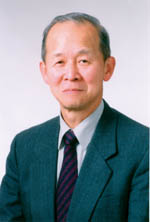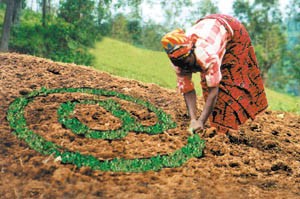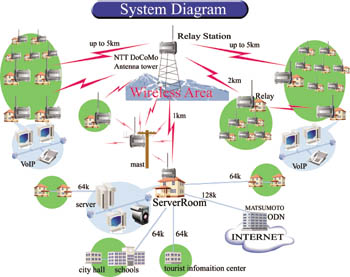Challenges for rural communications
development
The legacy of the Maitland report
 Yasuhiko Kawasumi, General Manager Yasuhiko Kawasumi, General Manager
JAPAN TELECOM CO., LTD
Nearly twenty years ago, the
Plenipotentiary Conference of the International Telecommunication Union
(Nairobi, 1982) adopted a resolution that led to the establishment in May
1983 of the renowned Independent Commission for World-Wide
Telecommunications Development chaired by Sir Donald Maitland. The Nairobi
Conference took this momentous decision convinced that the United Nations
General Assembly had proclaimed 1983 as “World Communications Year” to
provide the opportunity for all countries to undertake a comprehensive review
and analysis of their policies on communications development.
In a nutshell, the Independent Commission’s mandate was to
identify the obstacles hindering communications infrastructure development and
to recommend ways in which the expansion of telecommunications across the world
could be stimulated. In January 1985, the Commission submitted its report known
as The Missing Link to Richard Butler, then Secretary-General of ITU. “We
are grateful to you for inviting us to join the Commission”, Sir Donald said
in a letter transmitting The Missing Link report to Mr Butler. “The
challenge was formidable. But we found the task rewarding.”
Leaders from the developing world have been implementing the
recommendations given in what soon became known as “the Maitland report”.
Today, seventeen years later, the legacy of the Maitland report lives on and
remains a benchmark for policy-makers and telecommunication administrations in
developing countries. The target set in The Missing Link was that by the
early part of the 21st century virtually the whole of [humankind should be
brought] within easy reach of a telephone and of all the benefits this can bring”.
Pekka Tarjanne, who served as ITU Secretary-General from November 1989 to
January 1999, took this goal to heart and appealed to the United Nations “to
recognize the right to communicate as a basic human right”. Since then, higher
investment in telecommunication development, coupled with the implementation of
new technologies and innovative strategies, as well as the general understanding
of the socio-economic effect of communications infrastructure, have led to a
remarkable degree of telecommunication development observed in most of the
developing countries throughout the 1990s.
 Sir Donald Maitland, Chairman of the Independent Commission
for World-Wide Telecommunications Development, planting a symbolic tree on the
occasion of a meeting in Arusha (Tanzania) in October 1984 in the presence of Tanzanian authorities and
members of the Commission Sir Donald Maitland, Chairman of the Independent Commission
for World-Wide Telecommunications Development, planting a symbolic tree on the
occasion of a meeting in Arusha (Tanzania) in October 1984 in the presence of Tanzanian authorities and
members of the Commission
(ITU 850001) |
Whereas the goal set in the Maitland report is deemed to be a
realistic and achievable target, the progress of digital technologies and the
proliferation of Internet-related services and applications have brought us new
challenges. At ITU TELECOM 99, ITU Secretary-General Yoshio
Utsumi set a new
goal in his opening speech, namely: to bring Internet-style services to all
humankind within the first decade of the new millennium, and apply all the new
technologies and impulses so that the gap in connectivity to the Internet can be
reduced.
This digital era, which emerged during the mid-1990s, has
brought with it corollary questions that are being addressed in both the developing
and the developed world under the catchword: “the digital divide”. In June
2000, a meeting of the G8 countries discussed the growing digital divide and
came up with the Okinawa Charter on the Global Information Society. One
year later in July 2001, the G8 countries focused again on the digital divide at
their Genoa Summit. Besides these events, the United Nations and many of
its agencies are actively looking for workable solutions to the digital divide.
ITU is the most relevant UN agency in this search for viable solutions;
particularly as regards basic information infrastructure.
ITU action since Valletta
The second World Telecommunication
Development Conference, held in Valletta (Malta) in March 1998, called for
the development of new technologies designed to meet the needs of developing
countries. For many years, developing countries voiced concern over ITU’s
allocation of resources for standardization activities with primary
applicability to developed countries. There was a feeling that developing
countries were forced to purchase unnecessarily expensive telecommunication
equipment made for developed countries. A proposal for ITU to tackle this
problem was adopted at WTDC–98 as Topic 7* in an annex to the “Valletta Action
Plan Programmes”.
| * This topic is listed in Chapter II of
“the Valletta Action Plan Programmes” under Annex 1 entitled List of
topics approved by the Conference for incorporation into the BDT Operational
Plan”, section A: “Topics related to focus groups.” |
Focus Group 7 (named after Topic 7) was set up in April 1999
at a meeting of the Telecommunication Development Advisory Group (TDAG) to “study
various mechanisms by which to promote the development of new telecommunication
technologies for rural applications”. With the assistance of contributions,
particularly from Japan, a website to track developments in rural
telecommunications has been created and can be found at www.itu.int/ITU–D/fg7.
The final report of Focus Group 7 entitled “New
Technologies for Rural Applications”, was released in February 2001 and has
been published in three languages in print and CD-ROM versions. The report
highlights emerging technologies suitable for use in rural and remote areas, and
their applications for distance education, telemedicine, small business
development, emergency support, disaster relief and environmental monitoring. It
concludes that wireless access technologies, combined with packet-based Internet
protocol (IP) networks, can be used in the rural and remote areas of developing
countries because of their cost effectiveness, fast roll-out time and capability
for affordable and sustainable multimedia services.
The report makes six recommendations to the Director of the
Telecommunication Development Bureau (BDT), which underscore the need to promote
the development of rural communications as one way of bridging the digital
divide. In essence, they call on BDT to:
-
Promote the development of low-cost information
appliances for rural use.
-
Create a renewable energy handbook on small-scale power
systems for rural information and communication technologies.
-
Increase collaboration with micro-finance organizations
to help develop communication-based rural businesses and applications.
-
Conduct pilot projects of packet-based wireless access
infrastructure for multimedia applications.
-
Maintain and expand the ITU website related to the work
on new technologies for rural applications.
-
Hold a symposium on new technologies for rural
applications.

Wireless access technologies, combined with packet-based Internet protocol (IP) networks,
can be used in the rural and remote areas of developing countries
|
Planned pilot projects
A Task Force, made up of
volunteers from among Focus Group 7 members, was set up during the fourth TDAG
meeting in October 2000 to advise and assist BDT in implementing the six
recommendations. The Task Force met three times in the twelve months leading up
to October 2001, and drafted the selection criteria needed for the location of
pilot projects, along with the Request for Proposals document to encourage developing
countries to submit their project proposals to BDT. Phase 1 of this planned
pilot project programme foresees the selection of five countries from Africa,
Asia, Latin America, Arab States and the Commonwealth of Independent States
(CIS) on the basis of their proposals. Modest financial and in-kind resources
from ITU, the private sector, funding organizations and recipient countries
will be mobilized with a view to implementing selected pilot projects. Hamadoun
I. Touré, BDT Director, has called for partnerships with administrations and
Sector Members in order to implement the recommendations on new technologies for
rural applications. He is also seeking collaboration with other UN agencies, the
private sector, non-governmental organizations and interested organizations
or institutes in the information technology (IT) sector.
To reduce the cost of implementation, pilot projects will
most likely be conducted within a shared-facility, such as a university
extension centre, a hospital, a post office, or a telecentre in a rural
community. In-kind contributions, such as local personnel, transportation, basic
facility for equipment storage, are encouraged from recipient countries. At
present, three proposals have been submitted to BDT, and project refinement is
under way. Initial evaluation of proposals will include a review of geographical
site surveys, cost estimates and to verify the reference information provided
to ensure that it complies fully with the selection criteria. A number of key
elements will be considered in the selection process and include: a favourable
regulatory environment, an identified demand (existing or potential) for
telephone services, as well as for multimedia applications such as
tele-education, telemedicine, small business development, environmental
monitoring, governance and poverty reduction. The level of commitment from
the government and local authority is important as well.
 The future The future
More than 2.5 billion people, 40 per
cent of the planet’s population, live in rural and remote areas of developing
countries. Of the small fraction that has access to telecommunications, radio
broadcasting and voice telephony have traditionally been the main services
provided. Today, a wide variety of new telecommunication applications such as
e-mail, e-commerce, telehealth and telemedicine, among others, have made access
to interactive multimedia services as important for rural and remote
communities as voice connectivity alone. Since each rural district or community
requires a different mix of voice, text, image, video and audio communications
to best meet its needs, today’s telecommunication network operators must be
able to support a wide range of services, applications and bandwidth levels at a
reasonable cost.
The proposed pilot projects for providing multimedia services
such as voice, facsimile, data over the wireless IP-based platform for rural and
remote areas is a challenge for ITU, yet it represents a workable option to help
bridge the digital divide. Internet-type services will be implemented cost
effectively, with fast roll-out time in the rural and remote areas of developing
countries. Islands of local communities with wireless IP-based platforms will be
interconnected by the satellite or inter-urban backbone system to the public
switched telephone network (PSTN) of the country for connectivity beyond its
borders.
One of the key issues for ITU in the promotion of
telecommunication development for rural and remote applications on a large
scale is how to mobilize the necessary financial resources. In this regard,
ITU’s initiative to hold the World Summit on the Information Society (WSIS) in
two phases — with the first in Geneva in 2003 and the second in Tunis in 2005 —
will surely increase collaboration with other United Nations agencies in
mobilizing the much-needed resources to connect rural and remote communities to
the rest of the globe. Providing connectivity for rural and remote communities
remains a critical challenge and responsibility of the ITU and its partners.
|